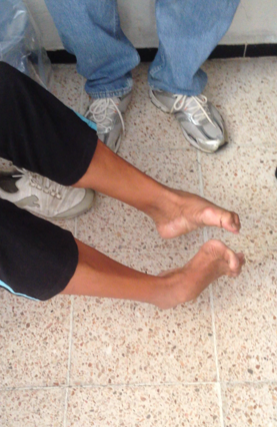Objective: To report a case of a 46 six years-old woman presenting with functional dystonia
Background: Nowadays we use the term dystonia when we are referring of patients with this movement disorder described by Oppenheim in a case series of 4 children with this condition. [1]
Dystonia has had different classifications, the most recent was published on Movement disorders on 2013 and classifies dystonia in two axes: the first one for clinical characteristics (age at onset, body distribution, temporal pattern and associated features) and the second for etiology. [2]
Functional dystonia can be divided in cranial, fixed and paroxysmal dystonia. Some clues to this condition are adult age of onset, atypical response to medication, high phenomenological variability of the episodes, absence of sensory tricks and involvement of legs. [3]
Method: We report one 46-years-old female with history of progressive feet hypertonia which has been managed with levodopa/carbidopa and gabapentin with no response. Her family history was irrelevant, and her past medical history had no relevance.
Results: On physical examination, her vital signs were unremarkable. The neurological examination was only relevant for hypertonia on the four limbs, with hyperreflexia and diminished strength 4/5 on the four extremities. The plantar response was flexor bilaterally. Her feet had a dystonic posture that did not showed a geste antagoniste [figure1].
Serum exams were unremarkable. A simple magnetic resonance imaging was practiced and showed no abnormalities.
Conclusion: She was diagnosed with functional dystonia and we started management with patient education and citalopram 20 mg and quetiapine 25 mg daily. One week after the initial evaluation the patient was seen at our clinic and the dystonia was fully resolved.
References: [1] Klein C, Fahn S. Translation of Oppenheim’s 1911 paper on dystonia. Movement Disorders. 2013;28(7):851-862.
[2] Albanese A, Bhatia K, Bressman S, DeLong M, Fahn S, Fung V et al. Phenomenology and classification of dystonia: A consensus update. Movement Disorders. 2013;28(7):863-873.
[3] Ganos C, Edwards M, Bhatia K. The Phenomenology of Functional (Psychogenic) Dystonia. Movement Disorders Clinical Practice. 2014;1(1):36-44.
To cite this abstract in AMA style:
F. Rivas, I. Rodríguez, D. Vázquez. Functional dystonia on a 46 year-old woman [abstract]. Mov Disord. 2022; 37 (suppl 2). https://www.mdsabstracts.org/abstract/functional-dystonia-on-a-46-year-old-woman/. Accessed April 20, 2025.« Back to 2022 International Congress
MDS Abstracts - https://www.mdsabstracts.org/abstract/functional-dystonia-on-a-46-year-old-woman/

